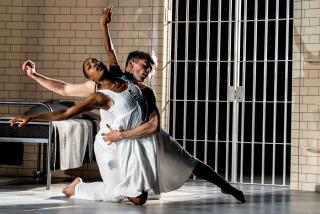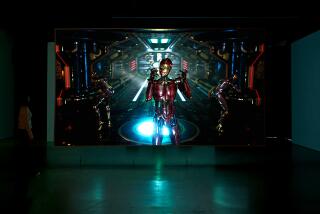Wim Vandekeybus asks dancers to dig deep
VENICE, Italy — Over strong espressos and crunchy biscotti in the garden at Hotel La Fenice et des Artistes, choreographer-filmmaker Wim Vandekeybus does not seem like a man who puts his dancers through agonizing paces. Indeed, his adrenaline-laced work — second nature to him — is more a badge of honor worn by members of his Brussels-based troupe, Ultima Vez.
But on this cloudy morning, the Flemish-born, soft-spoken artist takes time both to reflect and to express a bit of apprehension over his newest piece, “Booty Looting,” which would make its debut in June as part of the eighth edition of Venice’s Dance Biennale later that night.
“I’m very quiet during the creation, but still at the end I got big pressure — how we fit things together,” he said. “It’s a big, risky piece, and I don’t want to make it too easy for the spectators or the dancers.”
PHOTOS: Arts and culture in pictures by The Times
Filled with signature Wim-isms, including thudding body tableaux as well as an on-site photographer documenting the proceedings — think Weegee meets Stanley Kubrick — the work received favorable notices from the European press.
No surprise, really, as Vandekeybus triumphed right out of the box. In 1987, his first work, “What the Body Does Not Remember,” not only catapulted him into the ranks of elite dance makers that included Anne Teresa de Keersmaeker but earned him a Bessie Award the following year.
Flash-forward a quarter century and “Body” has been remounted with new dancers for a 25-year anniversary world tour (in repertory with “Booty Looting”). After stops in Belgium, Italy and Australia, “Body” lands at Royce Hall March 15 and 16 in its Los Angeles premiere as part of the Center for the Art of Performance at UCLA season. (The troupe was last seen in L.A. in 2008, when it performed “Spiegel,” excerpts from six Vandekeybus works, including scenes from “Body.”)
“It’s really strange to again do this piece,” says Vandekeybus, 49, “because it was like yesterday. Half the crew who are playing now was not born, because they are younger than 25.
“Suddenly,” he adds wryly, “the piece became a revolution in dance. Because it was very physical it changed something. I didn’t have any technique, but it was more by not knowing that you created something new. Now, of course, you know more, but I still try to reinvent myself and also stay quite truly to myself.”
Vandekeybus, who’s made more than two dozen dances and a number of films, comes by catastrophic scenarios, well, naturally: The son of a rural veterinarian, he routinely witnessed cat castrations and farmers in “states of urgency.” That raw physicality translated itself into the shock and awe of his confrontational works: brick throwing and catching, dancers stomping on one another and a violent eroticism, all evidenced in the boundary-shattering “Body.”
The New York Times’ Anna Kisselgoff called it “tough, brutal, playful, ironic and terrific.” Vandekeybus was part of the original cast, as was Spanish dancer Eduardo Torroja, who was also credited with assistant direction in 1987. For this revival, Torroja has run many of the rehearsals and will tour with the dancers to keep them in fighting shape. He’ll also make sure the production remains razor-sharp.
“You need to go back to the memory of the people, and because Eduardo and I did it so many times,” points out Vandekeybus, “we are very demanding, and we wanted to transmit what we felt inside this excitement, this eagerness. I think these new dancers got very close to what we did.”
And although Vandekeybus still performs with his troupe (he was recently seen as Oedipus in Jan Decorte’s version of “Oedipus/Bêt Noir”), the Belgian says he wouldn’t fit in with this new generation.
“But, seeing it again, from a distance,” he says, “is now like a meditation. It’s so pure, so strong. It’s also a very abstract work that is deep and touching, but you don’t know why.”
Kristy Edmunds, CAP UCLA’s executive/artistic director, says she was “stunned” when she first saw the work in Seattle in 1987. She also knew she wanted to program it as part of her first season in Los Angeles.
“It made me think about dance differently, and it continues to have that power. Wim’s interest in bringing it back to life is both dance history and a contemporary application — where we are now in relation to that work in a different time period. I think it will be artistically fascinating.”
Thierry De Mey and Peter Vermeersch’s original score accompanies a fiendishly difficult, 85-minute workout for the piece’s nine performers.
Hawaiian-born Eddie Oroyan, 34, auditioned with some 500 others and was asked to join Ultima Vez in 2011. He says the dance feels like “equal parts sport and art,” adding, “when I dive for a stone, I’m not thinking about the landing but doing it with everything I have. I deal with the next challenge when I get to that.
“When the piece is over, there’s this blissful feeling of a warrior that survived the tiger.”
For Vandekeybus, who recently moved his troupe to a new building and also received East Flanders’ Keizer Karel prize for his contribution to the arts, he’s not concerned whether “Body” can still shock.
“‘Shock’ is a big word. In the meantime, people have seen many things and are used to seeing this language in different forms. Since 9/11, everybody’s afraid that any moment the worst could happen. I always had this, but as a creative mind. I don’t think it will be shocking but more special.”
Ultima Vez at CAP UCLA’s Royce Hall
8 p.m. March 15 and 16
$20 to $55
(310) 825-2101 or cap.ucla.edu
MORE
INTERACTIVE: Christopher Hawthorne’s On the Boulevards
Depictions of violence in theater and more
PHOTOS: Arts and culture in pictures
More to Read
The biggest entertainment stories
Get our big stories about Hollywood, film, television, music, arts, culture and more right in your inbox as soon as they publish.
You may occasionally receive promotional content from the Los Angeles Times.






